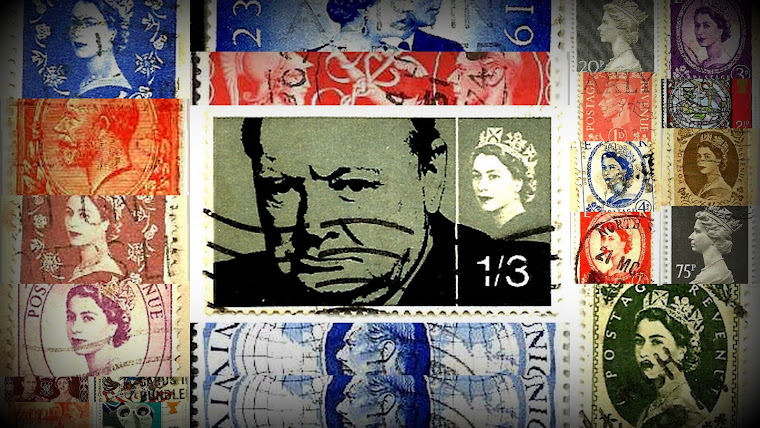 |
| 1952 -1954 Wilding Definitives Queen Elizabeth 1d blue (U K) 1952 |
 |
| 1952 -1954 Wilding Definitives Queen Elizabeth 1s3d green (U K) (1952) |
 |
| Wilding Definitives Queen Elizabeth 1s bistre (U K) (1952) |
 |
| Wilding Definitives Queen Elizabeth 2½d Stamp (1952) red ( with cancellation 21 MCH 52) (U K) |
 |
| Wilding Definitives Queen Elizabeth 2d brown (U K) (1952) |
 |
| Wilding Definitives Queen Elizabeth 3d lilac (U K) (1952) |
 |
| Wilding Definitives Queen Elizabeth 6d purple (U K) (1952) |
 |
| Wilding Definitives Queen Elizabeth 4d blue |
 |
| 1952 -1954 Wilding Definitives Queen Elizabeth 9d |
This is one of the stamps of 1952 -1954 Wilding Definitives Queen Elizabeth
When
Elizabeth II succeeded her father in 1952, new stamps were needed. The result was a collection of variations on a theme that came to be known as the
Wilding issues, based on a portrait of Queen Elizabeth II by photographer
Dorothy Wilding.
[8]
Wildings were used until 1967, when the
Machin issues were introduced on 5 June.
[9] The Machin design is very simple, a profile of the Queen on a solid colour background, and very popular, still being the standard British stamp as of 2012. They have been printed in scores of different colours; in addition,
decimalisation required new denominations, and there have technical improvements in the printing process, resulting in literally hundreds of varieties known to specialists.
Up to the 1950s, British commemorative stamps were few and far between: most of the stamps were definitive issues in which the portrait of the reigning monarch was the dominant element. Even after commemorative stamps began to appear more often during the 1950s and early 1960s, the monarch's effigy was prominent, usually taking up a quarter to a third of the stamp's design, which limited flexibility and creativity. A change came in 1965 when the then
Postmaster General Tony Benn issued new criteria for what could appear on stamps. Designer
David Gentleman wrote to Benn about alternative design approaches, suggesting the monarch's head be replaced by another national symbol, such as a Crown,
Royal Cypher or words such as "Great Britain" or "UK". A compromise, a small silhouette of
the Queen based on the coinage head of
Mary Gillick, was accepted and this has been the standard ever since for commemorative stamps.
[10] When the monarch's portrait is part of the stamp's main design (as for example in the case of issues commemorating
the Queen's birthday), then the silhouette is not needed and does not appear. (An exception to this rule occurred in 2000 when a souvenir sheet issued in commemoration of the
Queen Mother's 100th birthday included a stamp with a photograph of
the Queen and the silhouette.)
Another trend is the growing use of stamps to commemorate events related to the present Royal Family. Up to
Elizabeth II's accession in 1952 the only commemorative stamps to have been issued related to royal events were for
George V's Silver Jubilee in 1935,
George VI's coronation in 1937, and a 1948 issue to commemorate George VI's 25th wedding anniversary. Since 1952, however, stamps have been issued to commemorate many royal occasions:
- HM The Queen's silver (1977), golden (2002) and diamond (2012) jubilees
- the 40th anniversary of her accession (in 1992)
- her coronation in 1953
- her silver, gold and diamond wedding anniversaries (in 1972, 1997 and 2007)
- the 25th and 50th anniversaries of her coronation (in 1978 and 2003)
- her 60th and 80th birthdays (in 1986 and 2006)
- the weddings of her sons and daughter (Anne's in 1973, Charles' two weddings in 1981 and 2005, Andrew's in 1986, and Edward's in 1999; Anne's second wedding in 1992 was not commemorated)
- the wedding of her grandson Prince William, Duke of Cambridge in 2011
- her mother's 80th, 90th and 100th birthdays (in 1980, 1990 and 2000)
- The Prince of Wales' investiture and its 25th anniversary (1969, 1994)
- Prince William's 21st birthday in 2003.
With regard to previous monarchs, stamps were issued in 1987 to mark the 150th anniversary of
Queen Victoria's accession, and in 1997 to mark the 450th anniversary of King
Henry VIII's death. From 2008 to 2011 stamps were issued featuring all of England's kings and queens and also the Scottish
House of Stewart.
[11]
Common watermarks found on British stamps.



+Brown+++(U+K)+(1937).jpg)
+(1937).jpg)
+1948.jpg)

++(U+K).jpg)










+1953.jpg)